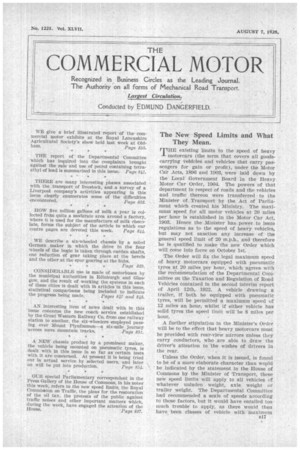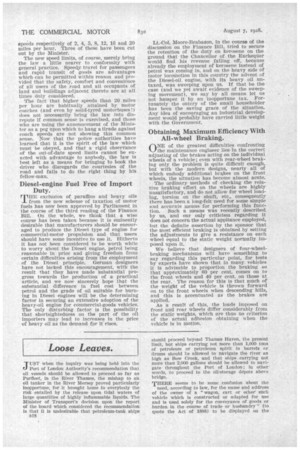The New Speed Limits and What They Mean.
Page 35

Page 36

If you've noticed an error in this article please click here to report it so we can fix it.
THE existing limits to the speed of heavy motorcars (the term that covers all goodscarrying vehicles and vehicles that carry passengers for gain or profit), under the Motor Car Acts, 1896 and 1903, were .laid down by the Local Government Board in the Heavy Motor Car Order, 1904. The powers of that department in respect of roads and the vehicles and traffic thereon were transferred to the Minister of Transportby the Act of Parliament which .created his Ministry. The maximum speed for all motor vehicles at 20 miles per hour is established in the Motor Car Act, 1903. Hence the Minister has power to issue regulations as to the speed of heavy vehicles, but may not sanction any increase of the general speed limit of 20 m.p.h., and therefore he is qualified to make the new Order which will come into force on October 1st.
The Order will fix the legal maximum speed of heavy motorcars equipped with pneumatic tyres at 20 miles, per hour, which agrees with the recommendation of the Departmental Com-• mittee on the Taxation and Regulation of Road Vehicles contained in the second interim report of April 12th, 1922. A vehicle drawing a trailer, if both be equipped with pneumatic tyres, will be permitted a maximum speed of 12 miles an hour, whilst if either vehicle has solid tyres the speed limit will be 8 miles per hour.
A further stipulation in the Minister's Order will be to the effect that heavy motorcars must be provided with rear-view mirrors Unless they carry conductors, who are able to draw the driver's attention to the wishes of drivers in the rear.
Unless the Order, when it is issued, is found to be of a more elaborate character than wonid be indicated by the statement in the House of Commons by the Minister of Transport, these new speed limits will apply to all vehicles of whatever unladen weight, axle weight or trailer weight. The Departmental Committee had recommended a scale of speeds according to those factors, but it would have entailed too much trouble to apply, as there would then have been classes of vehicle with maximum speeds respectively of 2, 4, 5, 8, 12, 16 and 20 miles per hour. Three of these have been cut out by the Minister.
The new speed limits, of course, merely bring the law a little nearer to conformity with general practice. Speedy travel for passengers and rapid transit of goods are advantages which can be permitted within reason and provided that the safety, comfort and convenience of all users of the road and all occupants of land and buildings adjacent thereto are at all times duly considered.
The fact that higher speeds than 20 miles per hour are habitually attained by motor coaches (and even by solid-tyred motorbuses !) does not necessarily bring the law into disrepute if common sense is exercised, and those who are using the announcement of the Minister as a peg upon which to hang a tirade against coach speeds are not showing this common sense. Now that the police authorities have learned that it is the spirit of the law which must be obeyed, and that a rigid observance of the out-of-date speed limits cannot be exacted with advantage to anybody, the law is best left as a means for bringing to book the driver who disregards the courtesies of the road and fails to do the right thing by his fellow-man.
Diesel-engine Fuel Free of Import Duty.
THE exclusion of paraffins and heavy oils from the new scheme 'of taxation of motor fuels has new been approved by Parliament in the course of the third reading of the Finance Bill. On the whole, we think that a wise course has been taken because it is eminently desirable that manufacturers should be encouraged to produce the Diesel type of engine for commercial-motor propulsion and that users should have some incentive to use it. Hitherto it has not been considered to be worth while to worry about -the Diesel engine, petrol being reasonable in price and giving freedom from certain difficulties arising from the employment of the Diesel principle. German designers have not lacked this encouragement, with the result that they have made Substantial progress towards the production of -a practical article, and we now sincerely hope that the substantial difference in fuel cost between petrol and the grade of oil suitable for burning in Diesel engines will be. the determining factor in securing an extensive adoption of the heavy-oil engine for commercial-goods vehicles. The only disturbing factor is the possibility that shortsightedness on the part of the oil
• importers may lead to increases in the price of heavy oil as the demand for it rises. • Lt.-Col, .Moore-Brabazon, in the course of the discussion on the Finance Bill, tried to secure the retention of the duty on kerosene on the ground that the Chancellor of the Exchequer would find his revenue falling off, because already the employment of kerosene instead of petrol was .coming in, and on the heavy side of motor locomotion In this country the advent of the Diesel-oil engine, with its heavy oil untaxed, was sweeping upon us. If that be the case (and we yet await evidence of the sweeping movement), we say by all means let us not hamper it by an inopportune tax. Fortunately the outcry of the small householder has been the saving grace of the situation. Any idea of encouraging an Industrial development would probably have carried little weight with the Government.
Obtaining Maximum Efficiency With . All-wheel Braking.
ONE of the greatest difficulties confronting the maintenance engineer lies in the correct adjusting of the brakes acting on the individual wheels of a vehicle; even with rear-wheel braking only the problem is quite difficult enough, but with the .modern designs, nearly all of which embody additional brakes on the front wheels, the situation has become almost acute.
The ordinary methods of checking the relative braking effort on the wheels are highly unsatisfactory, and do not allow for wheel loading, torsion on the shaft, etc., consequently there has been a long-felt need for some simple and accurate means for performing this function. Such a means was recently described by us, and our only criticism regarding it does not concern the actual appliance employed, hut the definite assertion by the sponsor that the most efficient braking is obtained by setting the adjustments to give a resistance on each wheel equal to the static weight normally lin posed upon it. We believe that designers of four-wheelbraking mechanisms will have something to say regarding this particular point, for tests by experts have shown that in many vehicles it is advisable to proportion the braking so that approximately 60 per cent, comes on to the front wheels and 40 per cent, on those at the rear. The reason for this is that much of the weight of the vehicle is thrown forward on to the front wheels when descending hills, and this is accentuated as the brakes are applied.
As a result of this, the loads imposed on front and rear wheels differ considerably from the static weights, which are thus no criterion of the actual adhesion obtaining when the vehicle is in motion.




































































































